Should NASA Send New Horizons To A Nearby Star For Its Final Mission?










Should NASA Send New Horizons To A Nearby Star For Its Final Mission?
“Over the next million years, the Voyagers and Pioneers will approach numerous stars, but only at relatively large separations. The closest will be Pioneer 10, encountering HIP 1177795 in ~90,000 years from 0.75 light-years away. But New Horizons, unlike the others, still has significant fuel remaining. After encountering Pluto and Arrokoth, it may yet target another object in the outer Kuiper belt. Subsequently, it will eventually enter interstellar space, but can be boosted to approach future stellar targets.”
In the 1970s, four spacecraft were launched with speeds large enough that they would eventually escape the Solar System: Pioneer 10 and 11 and Voyager 1 and 2. In the 2000s, New Horizons became the fifth spacecraft that will leave the Solar System and enter interstellar space. But unlike the other four, it still has fuel remaining and could boost itself to alter its trajectory. In the aftermath of the ESA’s Gaia mission, we now can predict where more than a billion stars in the Milky Way will be located up to a million years in the future, raising the possibility that we could alter New Horizon’s trajectory to encounter another solar system in the distant future.
Should we do it? Of course we should! Come learn about this fascinating possibility today.
More Posts from Sergioballester-blog and Others
Mars Helicopter: 6 Things to Know About Ingenuity

When our Perseverance Mars rover lands on the Red Planet on Feb. 18, 2021, it will bring along the Ingenuity helicopter.
This small-but-mighty craft is a technology demonstration that will attempt the first powered, controlled flight on another planet. Its fuselage is about the size of a tissue box, and it weighs about 4 pounds (1.8 kg) on Earth. It started out six years ago as an implausible prospect and has now passed its Earthbound tests.
Here are six things to know about Ingenuity as it nears Mars:
1. Ingenuity is an experimental flight test.

This Mars helicopter is known as a technology demonstration, which is a project that aims to test a new capability for the first time with a limited scope. Previous technology demonstrations include Sojourner, the first Mars rover, and the Mars Cube One (MarCO) CubeStats that flew by Mars.
Ingenuity does not carry any science instruments and is not part of Perseverance’s science mission. The only objective for this helicopter is an engineering one – to demonstrate rotorcraft flight in the thin and challenging Martian atmosphere.
2. Mars won’t make it easy for Ingenuity.

Mars’ atmosphere is around 1% the density of Earth’s. Because of that lack of density, Ingenuity has rotor blades that are much larger and spin faster than a helicopter of Ingenuity’s mass here on our planet. It also must be extremely light to travel to Mars.
The Red Planet also has incredibly cold temperatures, with nights reaching minus 130 degrees Fahrenheit (-90 degrees Celsius) in Jezero Crater, where our rover and helicopter will land. Tests on Earth at the predicted temperatures indicate Ingenuity’s parts should work as designed, but the real test will be on Mars.
3. Ingenuity relies on Perseverance for safe passage to Mars and operations on the Martian surface.

Ingenuity is nestled sideways under Perseverance’s belly with a cover to protect the helicopter from debris during landing. The power system on the Mars 2020 spacecraft periodically charges Ingenuity’s batteries during the journey to the Red Planet.
In the first few months after landing, Perseverance will find a safe place for Ingenuity. Our rover will shed the landing cover, rotate the helicopter so its legs face the ground and gently drop it on the Martian surface.
4. Ingenuity is smart for a small robot.

NASA’s Jet Propulsion Laboratory will not be able to control the helicopter with a joystick due to delays communicating with spacecraft across interplanetary distances. That means Ingenuity will make some of its own decisions based on parameters set by its engineering team on Earth.
During flight, Ingenuity will analyze sensor data and images of the terrain to ensure it stays on a flight path designed by project engineers.
5. The Ingenuity team counts success one step at a time.

Ingenuity’s team has a long list of milestones the helicopter must pass before it can take off and land in the Martian atmosphere.
Surviving the journey to and landing on Mars
Safely deploying onto the Martian surface from Perseverance’s belly
Autonomously keeping warm through those intensely cold Martian nights
Autonomously charging itself with its solar panel
Successfully communicating to and from the helicopter via the Mars Helicopter Base Station on Perseverance
6. If Ingenuity succeeds, future Mars exploration could include an ambitious aerial dimension.

The Mars helicopter intends to demonstrate technologies and first-of-its-kind operations needed for flying on Mars. If successful, these technologies and flight experience on another planet could pave the way for other advanced robotic flying vehicles.
Possible uses of a future helicopter on Mars include:
A unique viewpoint not provided by current orbiters, rovers or landers
High-definition images and reconnaissance for robots or humans
Access to terrain that is difficult for rovers to reach
Could even carry light but vital payloads from one site to another
Make sure to follow us on Tumblr for your regular dose of space: http://nasa.tumblr.com





Storm Clouds of Jupiter
This impressive storm captured by Geoff Green over West Australia in August 2018, gives you an idea of the huge frequency at which lightning happen in an extreme weather event
Instagram: wonders_of_the_cosmos


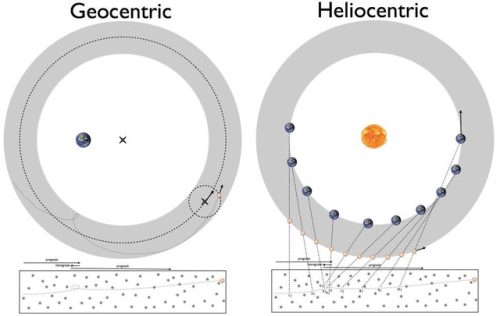






What Separates A Good Scientific Theory From A Bad One?
“It’s why an idea like dark matter is so powerful. By adding just a single new species of particle — something that’s cold, collisionless, and transparent to light and normal matter — you can explain everything from rotating galaxies to the cosmic web, the fluctuations in the microwave background, galaxy correlations, colliding galaxy clusters, and much, much more. It’s why ideas with a huge number of free parameters that must be tuned to get the right results are less satisfying and less predictively powerful. If we can model dark energy, for instance, with just one constant, why would we invent multi-field models with many parameters that are no more successful?”
You’ve often heard, when discussing competing scientific ideas, of appealing to Occam’s razor. Often paraphrased as “all things being equal, the simplest explanation is usually best,” it seems to open the door for people to argue over which explanation is simplest. This should not, however, be a point of contention: the explanation that’s simplest is the one that introduces the fewest number of new, additional free parameters. And when it comes to all things being equal, the things in question ought to be the number of new phenomena the novel idea can explain, along with the number of discernible predictions as compared with the old, prevailing idea. The best scientific ideas are the ones that explain the most by adding the least, while the worst ones unnecessarily add additional parameters on top of what we observe for no good reason other than personal bias. Ideas may be a dime-a-dozen, but a good idea is hard to find.
The next time you encounter an interesting, wild idea that someone throws out there, use this criteria to evaluate it. You just might be surprised at how quickly you can tell whether an idea is good or bad!

Shuttle Endeavour’s flight deck. 🚀
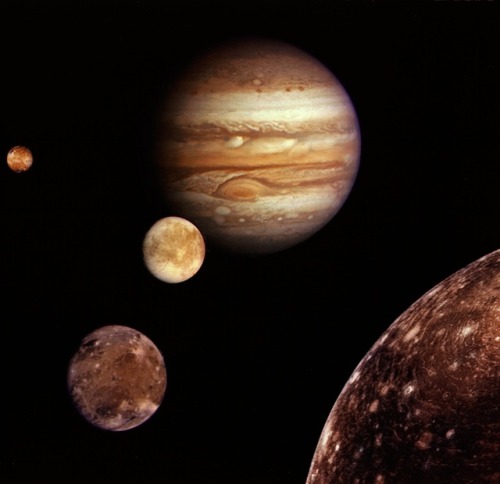
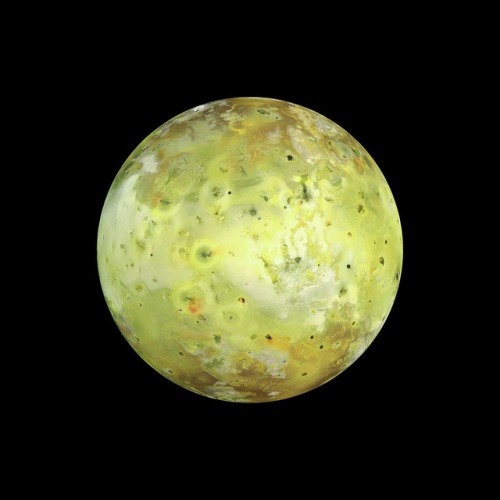
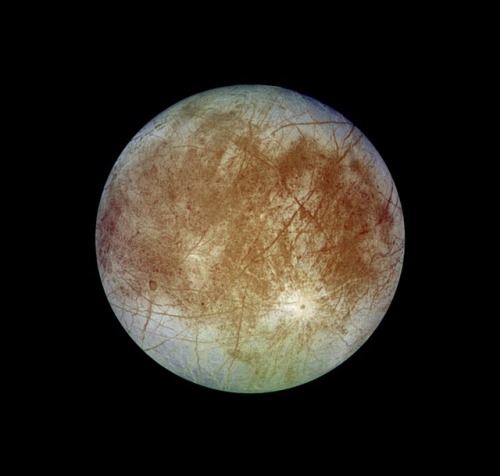
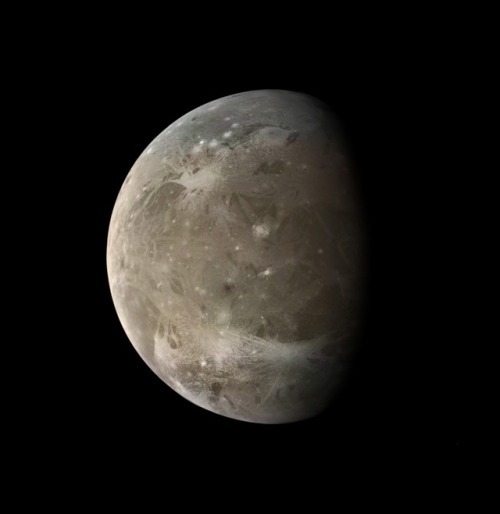
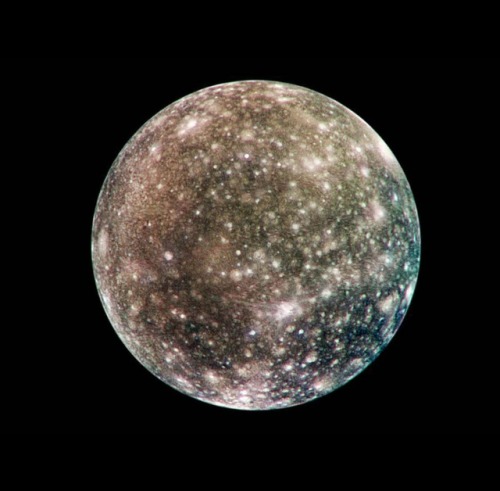
Galilean moons
The Galilean moons are the four largest moons of Jupiter — Io, Europa, Ganymede, and Callisto. They were first seen by Galileo Galilei in January 1610, and recognized by him as satellites of Jupiter in March 1610. They are the first objects found to orbit another planet. Their names derive from the lovers of Zeus. They are the first objects found to orbit another planet. Their names derive from the lovers of Zeus. They are among the largest objects in the Solar System with the exception of the Sun and the eight planets, with a radius larger than any of the dwarf planets.
Io is the fourth largest moon in the Solar System. With over 400 active volcanos, Io is the most geologically active object in the Solar System. Its surface is dotted with more than 100 mountains, some of which are taller than Earth’s Mount Everest. Unlike most satellites in the outer Solar System (which have a thick coating of ice), Io is primarily composed of silicate rock surrounding a molten iron or iron sulfide core. Although not proven, recent data from the Galileo orbiter indicate that Io might have its own magnetic field.
Europa the second of the four Galilean moons, is the second closest to Jupiter and the smallest at 3121.6 kilometers in diameter, which is slightly smaller than the Moon. The name comes from a mythical Phoenician noblewoman, Europa, who was courted by Zeus and became the queen of Crete, though the name did not become widely used until the mid-20th century. It has a smooth and bright surface, with a layer of water surrounding the mantle of the planet, thought to be 100 kilometers thick. The smooth surface includes a layer of ice, while the bottom of the ice is theorized to be liquid water. The apparent youth and smoothness of the surface have led to the hypothesis that a water ocean exists beneath it, which could conceivably serve as an abode for extraterrestrial life.
Ganymede is the largest moon in the Solar System, and is even bigger than the planet Mercury. It is the only satellite in the Solar System known to possess a magnetosphere, likely created through convection within the liquid iron core.
Callisto is the fourth and last Galilean moon, and is the second largest of the four, and at 4820.6 kilometers in diameter, it is the third largest moon in the Solar System, and barely smaller than Mercury, though only a third of the latter’s mass. It is named after the Greek mythological nymph Callisto, a lover of Zeus who was a daughter of the Arkadian King Lykaon and a hunting companion of the goddess Artemis. It is one of the most heavily cratered satellites in the Solar System, and one major feature is a basin around 3000 km wide called Valhalla.
source
image credit: NASA/JPL
Perseverance: Amazing descent & landing video taken by the rover’s EDL cameras.
NASA’s Search for Life: Astrobiology in the Solar System and Beyond
Are we alone in the universe? So far, the only life we know of is right here on Earth. But here at NASA, we’re looking.

We’re exploring the solar system and beyond to help us answer fundamental questions about life beyond our home planet. From studying the habitability of Mars, probing promising “oceans worlds,” such as Titan and Europa, to identifying Earth-size planets around distant stars, our science missions are working together with a goal to find unmistakable signs of life beyond Earth (a field of science called astrobiology).
Dive into the past, present, and future of our search for life in the universe.

Mission Name: The Viking Project
Launch: Viking 1 on August 20, 1975 & Viking 2 on September 9, 1975
Status: Past
Role in the search for life: The Viking Project was our first attempt to search for life on another planet. The mission’s biology experiments revealed unexpected chemical activity in the Martian soil, but provided no clear evidence for the presence of living microorganisms near the landing sites.

Mission Name: Galileo
Launch: October 18, 1989
Status: Past
Role in the search for life: Galileo orbited Jupiter for almost eight years, and made close passes by all its major moons. The spacecraft returned data that continues to shape astrobiology science –– particularly the discovery that Jupiter’s icy moon Europa has evidence of a subsurface ocean with more water than the total amount of liquid water found on Earth.

Mission Name: Kepler and K2
Launch: March 7, 2009
Status: Past
Role in the search for life: Our first planet-hunting mission, the Kepler Space Telescope, paved the way for our search for life in the solar system and beyond. Kepler left a legacy of more than 2,600 exoplanet discoveries, many of which could be promising places for life.

Mission Name: Perseverance Mars Rover
Launch: July 30, 2020
Status: Present
Role in the search for life: Our newest robot astrobiologist is kicking off a new era of exploration on the Red Planet. The rover will search for signs of ancient microbial life, advancing the agency’s quest to explore the past habitability of Mars.

Mission Name: James Webb Space Telescope
Launch: 2021
Status: Future
Role in the search for life: Webb will be the premier space-based observatory of the next decade. Webb observations will be used to study every phase in the history of the universe, including planets and moons in our solar system, and the formation of distant solar systems potentially capable of supporting life on Earth-like exoplanets.

Mission Name: Europa Clipper
Launch: Targeting 2024
Status: Future
Role in the search for life: Europa Clipper will investigate whether Jupiter’s icy moon Europa, with its subsurface ocean, has the capability to support life. Understanding Europa’s habitability will help scientists better understand how life developed on Earth and the potential for finding life beyond our planet.

Mission Name: Dragonfly
Launch: 2027
Status: Future
Role in the search for life: Dragonfly will deliver a rotorcraft to visit Saturn’s largest and richly organic moon, Titan. This revolutionary mission will explore diverse locations to look for prebiotic chemical processes common on both Titan and Earth.
For more on NASA’s search for life, follow NASA Astrobiology on Twitter, on Facebook, or on the web.
Make sure to follow us on Tumblr for your regular dose of space!
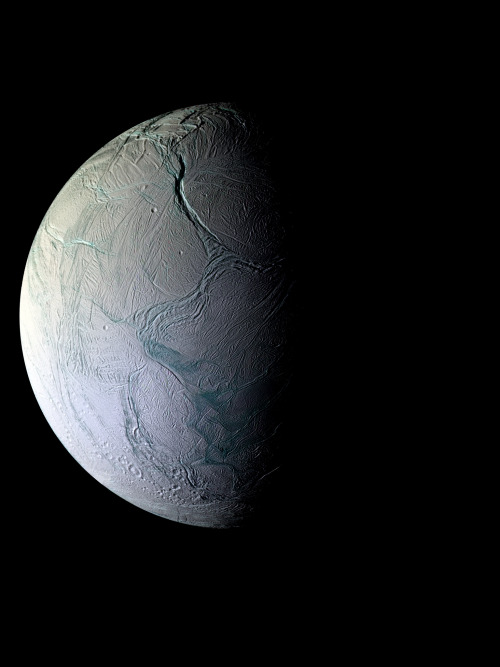
Image of the moon of Saturn, Enceladus, taken by the Cassini spacecraft
Image credit: NASA / JPL
-
 astrophysicsblogs reblogged this · 2 years ago
astrophysicsblogs reblogged this · 2 years ago -
 sergioballester-blog reblogged this · 4 years ago
sergioballester-blog reblogged this · 4 years ago -
 sergioballester-blog liked this · 4 years ago
sergioballester-blog liked this · 4 years ago -
 music-sadness-shetland liked this · 4 years ago
music-sadness-shetland liked this · 4 years ago -
 ever-student liked this · 4 years ago
ever-student liked this · 4 years ago -
 astarothssr liked this · 4 years ago
astarothssr liked this · 4 years ago -
 detaras reblogged this · 4 years ago
detaras reblogged this · 4 years ago -
 porcoboia66 liked this · 5 years ago
porcoboia66 liked this · 5 years ago -
 swimmingneckpalacerascal-blog liked this · 5 years ago
swimmingneckpalacerascal-blog liked this · 5 years ago -
 xamenos--kosmos liked this · 5 years ago
xamenos--kosmos liked this · 5 years ago -
 aysha-was-taken liked this · 5 years ago
aysha-was-taken liked this · 5 years ago -
 piperhowler liked this · 5 years ago
piperhowler liked this · 5 years ago -
 r2d2-artuditu liked this · 5 years ago
r2d2-artuditu liked this · 5 years ago -
 darknerdkidhuman liked this · 5 years ago
darknerdkidhuman liked this · 5 years ago -
 prgloss liked this · 5 years ago
prgloss liked this · 5 years ago -
 brattycattyk liked this · 5 years ago
brattycattyk liked this · 5 years ago -
 cloudlikeclownery liked this · 5 years ago
cloudlikeclownery liked this · 5 years ago -
 greatvoiddeputyparty-blog liked this · 5 years ago
greatvoiddeputyparty-blog liked this · 5 years ago -
 kerstin-jacobs liked this · 5 years ago
kerstin-jacobs liked this · 5 years ago -
 tesco-finest-aromantics liked this · 5 years ago
tesco-finest-aromantics liked this · 5 years ago -
 justrebelrunaways liked this · 5 years ago
justrebelrunaways liked this · 5 years ago -
 amberloo-02 liked this · 5 years ago
amberloo-02 liked this · 5 years ago -
 adventuringautumn liked this · 5 years ago
adventuringautumn liked this · 5 years ago -
 toto-blanton liked this · 5 years ago
toto-blanton liked this · 5 years ago -
 pablot802 liked this · 5 years ago
pablot802 liked this · 5 years ago -
 squicksquak liked this · 5 years ago
squicksquak liked this · 5 years ago -
 gnifrus liked this · 5 years ago
gnifrus liked this · 5 years ago -
 gnifrus reblogged this · 5 years ago
gnifrus reblogged this · 5 years ago -
 theelysiancosmos liked this · 5 years ago
theelysiancosmos liked this · 5 years ago -
 theowatson77 liked this · 5 years ago
theowatson77 liked this · 5 years ago -
 freerangemartian liked this · 5 years ago
freerangemartian liked this · 5 years ago -
 holdmybeersweety liked this · 5 years ago
holdmybeersweety liked this · 5 years ago -
 danoitey liked this · 5 years ago
danoitey liked this · 5 years ago -
 sne-runaway liked this · 5 years ago
sne-runaway liked this · 5 years ago -
 phantom-streaker reblogged this · 5 years ago
phantom-streaker reblogged this · 5 years ago -
 delightfultreebagelzipper-blog liked this · 5 years ago
delightfultreebagelzipper-blog liked this · 5 years ago -
 aesthetickya-blog liked this · 5 years ago
aesthetickya-blog liked this · 5 years ago -
 mutilatedmaryonmars reblogged this · 5 years ago
mutilatedmaryonmars reblogged this · 5 years ago -
 mentallyill18 liked this · 5 years ago
mentallyill18 liked this · 5 years ago -
 the-hraezlyr liked this · 5 years ago
the-hraezlyr liked this · 5 years ago -
 lizardpeoplecloneschemtrails reblogged this · 5 years ago
lizardpeoplecloneschemtrails reblogged this · 5 years ago -
 pictorix135 liked this · 5 years ago
pictorix135 liked this · 5 years ago